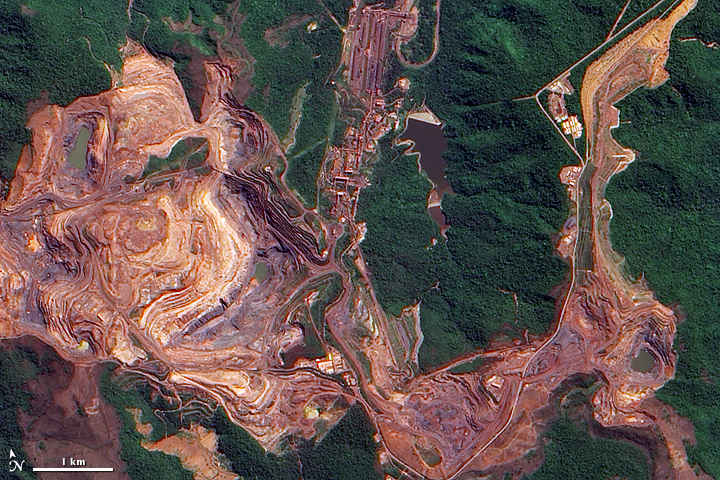鉱業
The Impact Of Mining On The Brazilian Amazon

In the Brazilian Amazon, mining caused 1.2 million hectares (12,000 square kilometers) of Amazon deforestation between 2005 and 2015 which represented around 9% of total Amazon forest loss during that period. With 98,300 hectares (983 square kilometers), 8% of this deforestation occurred within concessions. But the vast majority of the deforestation occurs outside of these concessions, due to the establishment of mining infrastructure, settlement expansion to support an increasing workforce attracted by economic development, and the creation of mineral commodity supply chains.
Brazil is the world’s second largest iron ore producer, and the fourth bauxite producer. Iron ore makes up almost 74% of the country’s mining sector based on 2020 tax figures. Several large, open-pit mining operations for iron ore, bauxite, and other minerals have been developed in the Brazilian Amazon biome. For both minerals, the Eastern Amazon and specifically the state Pará plays an important role.
Brazil is also an important producer of gold, nickel, tin, and zinc. In the Amazon rainforest, “small-scale” gold miners, so-called ‘garimpeiros’, are recently increasing their activity amidst soaring gold prices. According to estimates, these miners account for around one third of Brazil’s gold output. At the same time, illegal mining contributes an estimated 15% of the total gold output. Gold mining activities in the Amazon contribute to the growing deforestation and water contamination, as well as violence against Indigenous communities.
Vale is the leading Brazilian mining company and the second-largest iron producer globally, operating one of the world’s largest iron ore mines in Carajás (Pará), holding 7.2 billion metric tons of iron ore in proven and probable reserves. Important bauxite mines in the Amazon Biome include the Oriximina mine operated by the Mineração Rio-consortium and the Paragominas bauxite mine by Mineração Paragominas, both located in Pará and among the world’s richest sources for bauxite.
In 2020, Vale had 236 applications in the Brazilian Amazon registered with the National Mining Agency (ANM), among them many applications for research as a first step to obtain authorisation for exploration. Of these, 214 applications were on Indigenous lands. In September 2021, Vale announced it would drop all prospect rights in Indigenous lands in Brazil, and it returned 89 licenses for mineral research and mining activities in lands that interfere with Indigenous lands. However, the next month it filed for rights to explore two areas that border Indigenous lands and that will therefore impact them. In November 2021, Vale had 75 active mining applications overlapping Amazonian Indigenous lands registered in the ANM system.
Belo Sun Mining (Canada) tries to develop the controversial Volta Grande gold mine in Pará. The project, which is in advanced exploration stages, would be one of the largest open air gold mines in Latin America. It has been met with broad opposition, among others due to its wide overlap with Indigenous lands in the Amazon and the expected impacts on water resources. Until now court injunctions have been holding the project up, but the company keeps pushing for approval.
In 2020, in a push to further expand mining, the Brazilian government under President Jair Bolsonaro presented bill PL191/2020 to regulate commercial mining in protected Indigenous lands. Data from InfoAmazonia shows that over 2,500 requests have been made, covering an area of 5.6 million km2. This is an area larger than half of Brazil. Considering only existing mining requests overlapping with Indigenous lands in the Amazon, 17.6 million hectares (176,000 square kilometers) or 15% of total Indigenous lands in the area could be directly affected by mining if the bill is approved. The lands of 21 isolated groups concentrate 97% of all mining requests.